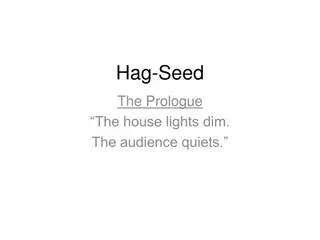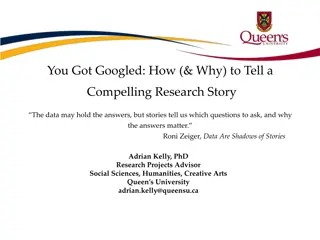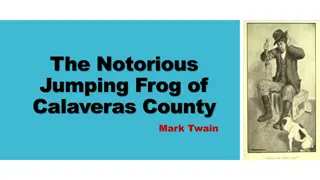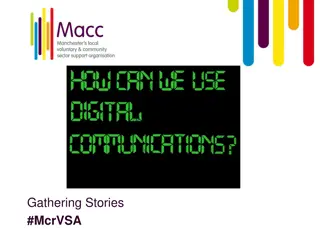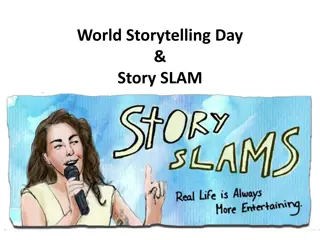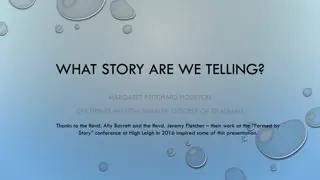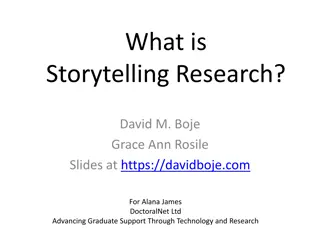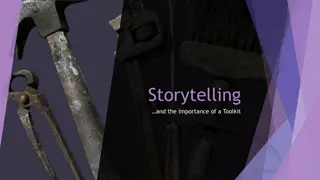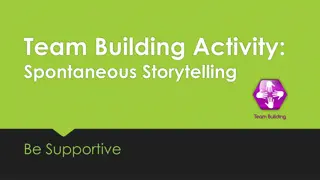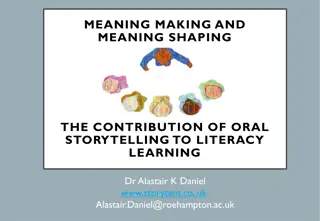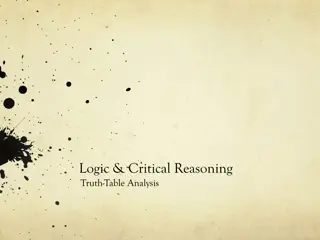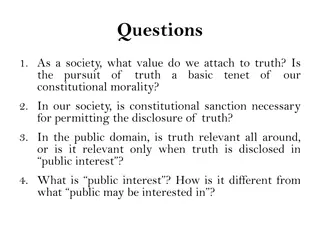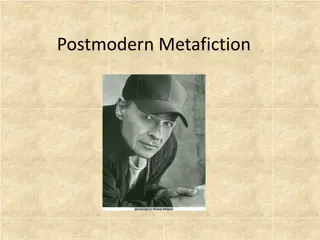Unveiling Truth: The Power of Storytelling in Influencing Perspectives
Stories hold the key to uncovering truths and shaping perspectives. The storyteller plays a crucial role in narrating their account authentically, while the listener's assumptions impact the narrative. Building rapport, genuinely listening, and summarizing are essential steps in revealing the real story within time constraints. The dynamic between storyteller and listener influences how narratives are shared and received, emphasizing the importance of understanding each other's perspectives.
Download Presentation

Please find below an Image/Link to download the presentation.
The content on the website is provided AS IS for your information and personal use only. It may not be sold, licensed, or shared on other websites without obtaining consent from the author.If you encounter any issues during the download, it is possible that the publisher has removed the file from their server.
You are allowed to download the files provided on this website for personal or commercial use, subject to the condition that they are used lawfully. All files are the property of their respective owners.
The content on the website is provided AS IS for your information and personal use only. It may not be sold, licensed, or shared on other websites without obtaining consent from the author.
E N D
Presentation Transcript
Velvet Rodriguez-Poston JD Megan Mclean-Stein JD MDR
An individuals story is their TRUTH. Stories are important because they lead us to facts that will eventually create the foundation necessary to determine the course of action to take in individual cases and will help us determine how to keep children safe and families safe. THE STORYTELLER is MORE important than the STORY.
There are truths about the storyteller imbedded within the story that are often even more important than the actual story. The storyteller experiences the story account as true We tell stories to make sense of things that are confusing, frightening, unsettling. Stories occur internally FIRST.
Both The Story Teller and the Listener Have A Direct Impact on The Story What kind of assumptions are you making about the person? And What kind of Assumptions are they making about you? These will have an impact on how the person tells their story and which version of the story
The storyteller is as interested in what you want to hear as what they want to tell. The storyteller may change his or her story depending on what he or she perceives you need as the listener. The storyteller has a need to be perceived in a favorable light. The storyteller needs to feel safety before revealing the deeper truths.
Getting to the REAL Story 3 STEP PROCESS Getting to the REAL Story 3 STEP PROCESS 1. BUILD RAPPORTAND SET EXPECTATIONS BUILD RAPPORTAND SET EXPECTATIONS 2. TAP INTO THE REAL STORY by LISTENING GENUINELY TAP INTO THE REAL STORY by LISTENING GENUINELY 3. SUMMARIZE AND CONCLUDE SET EXPECTATIONS OF THE NEXT STEPS CLEARLY SUMMARIZE AND CONCLUDE
Time constraints usually limit us to one hour or two hours with each client Usually we think of our process as follows: Beginning (Rapport Building) 3 minutes Middle (Actual Storytelling and Interviewing process) 50 minutes. Conclusion (3-4 minutes)
Beginning (Rapport Building) 25 minutes Middle (Story and Interviewing) 10 minutes Ending and Conclusion (25 minutes) Beginning (2 minutes) Middle (55 minutes) Conclusion and Follow Up (3 minutes) Beginning (2 minutes) Middle (20 minutes) Conclusion and Follow up (38 minutes)
Step ONE Rapport Building Step ONE Rapport Building The Length of time you engage in Rapport building depends on the type of verbal preferences that the storyteller has. SOME PEOPLE WILL REQUIRE A LENGTHY RAPPORT PROCESS AND SOME PEOPLE MAY NOT REQUIRE MUCH TIME
WILL USE MORE EMOTION BASED WORDS WILL FILTER INFORMATION THRU THEIR FEELINGS THEY WILL PROCESS INFORMATION FROM FEELINGS BASED PERSPECTIVE LOGIC BASED INDIVIDUAL WILL NOT BE AS EMOTIONALLY IMPACTED BY EVENTS TELL STORY IN SEQUENTIAL ORDER THEY WILL PROCESS INFORMATION FROM A LOGICAL PERSPECTIVE THEIR FILTER WILL IMPACT HOW THEY TELL THE STORY and The Type of Rapport They Will Need. THEIR EMOTION BASED PERSPECTIVE WILL IMPACT HOW THEY TELL THEIR STORY and Also How much Rapport They need.
NEEDS TO KNOW THAT THERE IS AN ORDER THE TASK IS MORE IMPORTANT THAN THE RELATIONSHIP THE SATISFACTION COMES FROM ACTUALLY ACCOMPLISHING A TASK NEEDS TO KNOW THAT THEY MATTER NEEDS TO KNOW THAT THEY ARE NOT JUST A TASK. NEEDS TO KNOW THEY ARE APPRECIATED . THE SATISFACTION COMES FROM THE CONNECTION. These Individuals will only need a 5 minute Rapport Building Time These Individuals will need a 25 minute to 30 minute building time.
Cannot Build Trust Without the Idle chit chat Cannot begin their story until they feel safe and connected with the interviewer The more time you invest in getting to know them the more credibility you have. Clear expectations need to be set in order for them to relax enough to tell their story. Forcing unnecessary relationship bonding will be viewed with great disdain. The longer you prolong getting to the task the less credibility you will have. Rapport Building Needs to Be SHORT for Logic Based TASK ORIENTED Individuals. Rapport Building NEEDS to be LONG. RSHP ORIENTED and Emotion Based Individuals.
Brief Introduction of yourself. Include your credentials Give your purpose, your intent, your time expectation and allow them the hope of leaving early if all goes well. Longer Introduction with more personal facts about yourself. Emphasize why you are there. Be open to discuss things that are irrelevant. Suggestions for Topics? Task Oriented Relationship Oriented
It is extremely important to greet people the way they would like to be greeted as opposed to the way we want to greet them. Watching and Observing People s Cues will give us insight as to how they would like to be greeted.
Your Ability to Adequately Read People and Act Appropriately will Give you Credibility or Take Credibility Away from You. Your ability to Greet People will automatically create safety or take away safety.
WHAT YOU SEE AND; WHAT YOU HEAR WHAT YOU FEEL IN THEIR GREETING (WHETHER IT BE A HANDSHAKE, A LACK OF HANDSHAKE ETC.)
REQUIRES GENUINE LISTENING, POSITIVE ATTITUDE AND A DESIRE TO SERVE OTHERS AS THEY ARE NOT WHO WE WANT THEM TO BE. We need to let our guard down and be totally honest and candid. We need to be advocates of what we believe in and totally honest about where we are coming from. We should be able to compromise and not be an island or a one man band.
Interview with Michael Interview with Michael What were some things that Michael said were effective in interviewing? What was the one quality of the interviewer that made Michael want to share more about himself?
I. WE NEED TO ESTABLISH A SAFE SPACE FOR PEOPLE TO SHARE THEIR STORY. . . I. WE NEED TO ESTABLISH A SAFE SPACE FOR PEOPLE TO SHARE THEIR STORY. . . AUTHENTICITY GENUINENESS DESIRE TO SERVE SO WE MOLD OUR STYLES TO THE STYLES OF THOSE WHOM WE SERVE. Pg 171 The Art of Waking People Up. WE need to create a process where the storyteller is more important than we are.
Why do you do what you do? Where is your foundation? Why do you do what you do? Where is your foundation? The dedication with which you do your job will reflect directly on those whom you speak with. Your personal purpose will shine thru with everyone whom you serve Your personal story will have a deep influence on people and they will either want to open up or not. If you establish a foundation of true listening and service the rest will come naturally.
Jonny The Bagger Jonny The Bagger What were some things that he did to help individuals at his place of work? Did he make simple changes or large changes? How can we make ourselves more accessible to people without compromising our time constraints? What expectations do we have of individuals when they tell us stories? Do we push our own agendas on them without establishing a foundation of authenticity? What if we approached individuals with the spirit of Jonny?
Common STYLES that you will see in Narration of Story: Common STYLES that you will see in Narration of Story: Bullet Point Narrative Cluster Linear What are your personal verbal preferences? Can you set those preferences aside and adapt to your storyteller s preferences?
OVERABUNDANCE OF DETAIL FULL STORY INCREDIBLY DIFFICULT TO INTERRUPT LENGTHY STORY IT WILL BE EASIER TO EXTRACT FACTS FROM THE STORY BECAUSE AT LEAST THERE IS A STORY. TIME CONSUMING ADVANTAGES DISADVANTAGES
BULLET POINT STYLE BULLET POINT STYLE CONCISE SHORTER IN TIME TO THE POINT MORE ALONG THE LINES OF WHAT WE WANT TO SEE WITHIN OUR OWN TIME CONSTRAINTS IT MAY MISS THE IMPORTANT FACTS OF THE STORY THAT WOULD BE RELEVANT IT MAY BE VERY DIFFICULT TO ACTUALLY TAP INTO THE STORY AS THE STORYTELLER MAY NOT BELIEVE THERE IS A STORY WORTH TELLING. DISADVANTAGES ADVANTAGES
WILL TELL THEIR STORY IN BULLET POINTS WILL NOT NECESSARILY HAVE A TRADITIONAL BEGINNING, MIDDLE AND END STORY MAY START WITH THE CONCLUSION MAY LEAVE OUT IMPORTANT FACTS SO EFFECTIVE QUESTIONING WILL BE NECESSARY. NARRATIVE INDIVIDUALS WILL TELL YOU THEIR STORY IN TRADITIONAL BEGINNING, MIDDLE AND END. INTERRUPTIONS WILL DERAIL THEIR STORY. THEY HAVE A NEED TO BE HEARD IN THEIR OWN ORDER OF EVENTS. NARRATIVE BULLETPOINT
YOUR PREFERENCES WILL IMPACT THE QUESTIONS YOU ASK AND THE STORY YOU TELL YOURSELF YOUR PREFERENCES WILL IMPACT THE QUESTIONS YOU ASK AND THE STORY YOU TELL YOURSELF ARE YOU LOGIC BASED? ARE YOU EMOTION BASED? DO YOU EXPECT A LONG NARRATIVE? DO YOU PREFER A BULLET POINT STORY? HOW ARE YOUR PREFERENCES INFLUENCING YOUR QUESTIONS, YOUR PERCEPTIONS OF THE STORYTELLER. YOU MAY BE PUSHING YOUR STORYTELLER AWAY BY GETTING IN THE WAY.
You will be able to ask more pointed and RELEVANT QUESTIONS. You will EMPATHIZE MORE. The storyteller will SAY more. You will be able to more effectively determine the CREDIBILITY OF THE STORY
SAFETY IN THE PROCESS SAFETY IN YOU. WILLINGNESS TO SHARE A MORE GENUINE TRUTH
A Little About Children Interviewing A Little About Children Interviewing Establishing SAFETY is a MUST!!! Rapport is must. You cannot underestimate the power of safety and rapport with children What are some things you can do to establish safety?
CONCLUSIONS AND FOLLOW UPS CONCLUSIONS AND FOLLOW UPS You may either encounter a SLOW PROCESSOR Or a FAST PROCESSOR. Slow processors cannot make decisions on the spot. They will feel taken advantage of. Fast processors can make decisions on the spot. For slower processors you will notice hesitancies in agreeing to certain premises that may seem obvious to you.
Slow Processors Slow Processors It is futile to attempt to pressure slow processors to share their story before they are ready to do so. You may need to schedule a follow up with them or use some other mechanisms to help them tell their story and come to agreements. Emails are a good way for them to process. You need to lengthen the time you take on the actual wrapping up of the case.
FAST PROCESSORS FAST PROCESSORS If you schedule a follow up with a faster processor they will lose credibility in you. Be willing to finish your job immediately and on the spot. Finishing may mean writing up a quick email with tenets of the agreements you came to and tenets of the discussion you had with them and a list of expectations. Your conclusion can take 10 minutes no follow ups necessary.
Tapping into the Story: Summarization Tapping into the Story: Summarization Rapport Building. Assess individuals from the moment you meet them. Don t waste time. Through Authentic and Genuine Purpose and knowledge of you who are as the listener Respect towards the individual s style of talking TAP INTO THE STORY Adjust your expectations and modify your process Allow the possibility of additional information after the formal interview Allow for the possibility of not needing to follow up if the individual does not need it. Effective Conclusions and Setting of Expectations
Courageous listening [to stories] is a form of shared responsibility. As such, it requires and encourages empowerment and ownership of results. It is an acknowledgment of equality and tangible evidence of respect and caring. The highest form of listening is one in which we care enough to discover what is not working in someone else s life, and in exchange for their willingness to do the same for us, communicate our open, honest, caring, humble, respectful assessment of how they might become even better at doing what they want to do, and being more authentically who they already are. The Art of Waking People Up Kenneth Cloke and Joan Goldsmith



